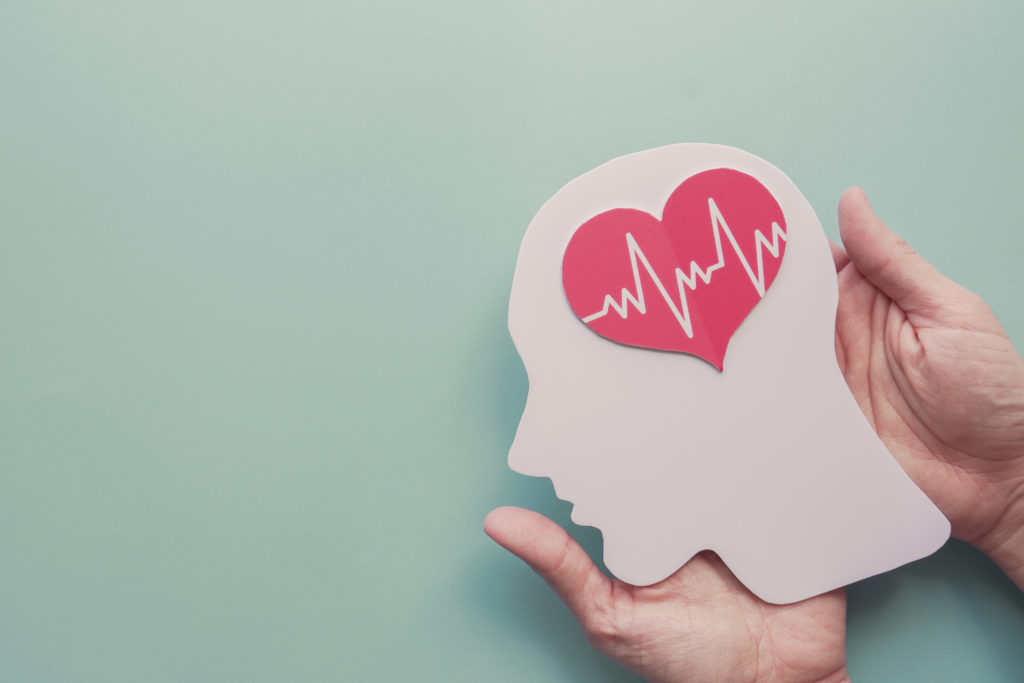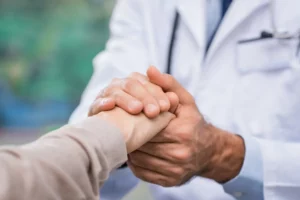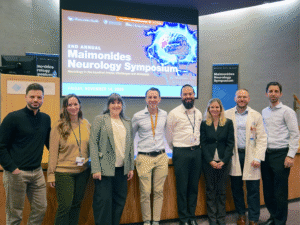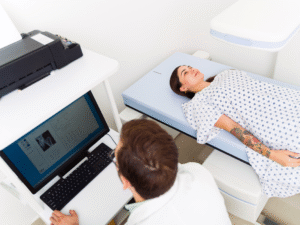Summary
Stroke can be a complicated and scary topic, but it’s important to stay informed, especially about warning signs. Join us as Tony Wang and Dr. Sanskriti Mishra discuss new therapies and treatments, and what we understand about treating strokes is leading to improved outcomes.
Listen on Spotify Listen on Apple Podcasts Listen on Google Podcasts
Transcript
Alyne Ellis: Every year, hundreds of thousands of Americans have a stroke and many sustain significant changes in ability. But now, with advances in medical, surgical and post-stroke care, some outcomes are really improving. Here to tell us more are Dr. Tony Wang, the director, and Dr. Sanskriti Mishra, the associate director of the Jaffe Comprehensive Stroke Center at Maimonides. at my mom buddies. This is Maimo Med Talk. I’m your host, Alyne Ellis. So Dr. Wang, let’s start with you. What is a stroke?
Dr Q Tony Wang: So a stroke is a neurological deficit clinically that is caused by two types of mechanisms. One is a blood vessel blockage that decrease blood flow to certain parts of the brain, causing neurological deficits. The other type is blood actually coming out of the blood vessels, causing damage over the area that is not supposed to be. That’s the definition of stroke.
Alyne: And what happens when a stroke occurs?
Dr Q Tony Wang: As you can Imagine, when the stroke strikes, the area supplied by the blood vessel, either that was blocked or the vessel ruptured causing local hemorrhage, the area controlling the function of the body will be affected. So typically, you will have symptoms such as focal weakness, unilateral or one side weakness, numbness, speech difficulties, visual complaints or visual loss or, sometimes in severe cases, loss of consciousness,
The symptoms, we can use an acronym called BE FAST, meaning the balance can be affected, people’s ability to control their balance; eyes, lost of vision; and facial droops, face; arm or leg weakness; speech difficulties. So BE FAST. T for time, for call 911.
Alyne: So I know there are different kinds of strokes, but it sounds like the deficits that you may sustain are pretty much basically the same, whatever kind of stroke there is.
Dr Q Tony Wang: Actually, it’s different. Every stroke comes in different symptoms, depends on the location of the stroke and also the size of the stroke, area that’s affected in the brain. And besides the brain, actually the retina and also spinal cord can also have stroke as well, causing neurological deficits, including vision loss, and also focal deficits.
Alyne: And who is basically at risk for a stroke?
Dr Q Tony Wang: Every one is at risk for stroke with different degree of risks factors. The people who have chronic conditions, such as hypertension, diabetes, high cholesterol levels, and obesity. And also certain genetic disorders that increase their risk of clotting or other illicit drug use, alcohol, smoking can also increase the risk of stroke or both types.
Alyne: So Dr. Wang, if you could please explain what are the different kinds of strokes.
Dr Q Tony Wang: So there are mainly two types of strokes. One type is the blocking type of stroke, when blood can go to the place in the brain causing the brain tissue to die to cause neurological deficits, so-called ischemic stroke. The other type is the hemorrhagic type. It’s a bleeding type where the blood came out of the blood vessels into the brain tissue. So that can cause damage because of the blood in the brain outside of the blood vessel. Those are the two types of strokes with different causes for each one particularly.
Alyne: So let’s talk a little bit about the treatment once a stroke is happening, and that is, I guess, on three fronts, medical, surgical, and post-stroke care. If you could list some of the things that are happening, that the patient will then have as treatment.
Dr Q Tony Wang: Sure. Exactly as I said, there are three types of treatment offered to the patient when someone develops acute stroke symptoms. The most important treatment is actually currently we can reverse the stroke process for a schemic type of stroke. If they come in early enough, we can offer treatment such as IV thrombolytics, meaning a clot-buster that can dissolve the clot readily if patient comes in within four and a half hours from symptom onset in eligible patients. Not everyone is eligible for the treatment, but if they are, they come in early enough, they’re given a chance of reopening a vessel by dissolving the clot through this medication, given intravenously.
There are other additional treatment options. Surgically, we can minimally invasively go into the blood vessels in the brain, through either arm or the leg. Under x-ray guidance, we can remove the clot mechanically to restore the flow to the blood vessel in the area to decrease the size of the stroke or damaged brain to restore function. And the other treatment is postop post- initial phase. then we can identify the underlying cause of the stroke to treat them to prevent secondary recurrence or to prevent progression of the stroke, including bleeding or other type of damages.
Alyne: So Dr. Mishra, what about the new kinds of innovations that are taking place in stroke treatment?
Dr Sanskriti Mishra: First of all, let me start by saying it is an exciting time to be a stroke neurologist. It’s a very dynamic field. In terms of innovations going on currently, as Dr. Wang mentioned, we have a clot-busting medication called tPA. The time window to give this medication has been three hours for most people and up to four and a half hours for certain group of patients. But recently, there’s been studies that have shown that we might be able to give this medication up to nine hours using advanced CAT scans. And so this is really an upcoming innovation in stroke care, which we’re hoping will become a practice in the future.
We also have other clot-busting medications such as tPA. There is a drug called tenecteplase, which is a modified version of the tPA that actually is more specific to the clot. It is easier to use and has shown promising results in early trials. Additionally, over the last one or two years, we’ve also expanded the time window for clot retrieval, so a procedure like Dr. Wang mentioned, when he can go in and remove the clot using thrombectomy. Initially, the window used to be six hours, but over the last year or two, the time window has expanded up to 24 hours from when a patient has their stroke symptoms.
And additionally, just to guide all these stroke decisions, imaging has been an important part. So there’s been a lot of advancement in the software that we use to tell us where the clot is, what part of the brain has been damaged and how much of the brain we can still save by treatments such as tPA and clot retrieval.
Lastly, for a hemorrhagic stroke, which is bleeding in the brain, we do have minimally invasive surgery in contrast to the past where the surgeon would really take off the whole bone flap. We have endoscopy procedure where they can make a small burr hole and really use a camera to navigate and remove the blood.
Alyne: And Dr. Mishra, could you also tell us how a stroke can affect women in particular and also young people?
Dr Sanskriti Mishra: So stroke Affects women and men differently. Stroke is a major cause of death in women. Generally, men are considered higher risk for stroke itself. But because life expectancy in women is higher, a majority of the stroke deaths are actually seen in women.
So symptoms-wise, it might present differently in women. The complaints could be more nonspecific. We mentioned weakness on one side, speech difficulty, visual difficulty, but women could have things like confusion, just feeling generally weak, fatigue. And also there’s some research that shows that women really tend to seek medical care less than men or their medical care might be more delayed. So those are some things to be aware of when we’re dealing with women with stroke.
Additionally, there are other risk factors that we look at for stroke in women. So women’s risk for stroke really varies throughout their life. So migraine with aura is considered a risk for stroke and it is seen primarily in women, especially in younger women. The risk of stroke also increases in pregnancy, especially towards the third trimester as well as post-pregnancy.
Lastly, estrogen use has also been shown to be a risk factor for stroke, and that can be seen in women who are using birth control pills or they’re using hormone replacement therapy for menopausal women. Therefore, it’s really important to look at each woman really separately and look at their risk factors and evaluate them in these contexts.
When it comes to young people, about 10 to 20% of strokes occur in young people. And when we say young, we mean really people who are less than 50 years of age. The causes of stroke in this population is different. It’s more common to see causes such as congenital heart disease, also dissection of the arteries in the brain, dissection which is a tear in the vessel wall of the artery.
However, recently, we have noted that ischemic stroke especially is increasing in the young, and we think it is due to the increase in modifiable risk factors as well in these people. So we’re seeing youth developing diabetes at a very younger age than say few years ago. They’re developing high blood pressure, high cholesterol. There’s more smoking, more obesity that’s being seen in the youth. And so we’re seeing that people continue to have stroke at a younger age.
Also younger adults have a high risk for recurrent stroke. And therefore, it’s really important that the youth really is educated on the above risk factors early in their lives and they really maintain their primary care on a regular basis.
Alyne: Thank you. So, Dr. Wang, what does it mean when a hospital is a comprehensive stroke center?
Dr Q Tony Wang: I want to actually add on to what Dr. Mishra just mentioned that the innovation for stroke care has been wonderful in leaps and bounds. For example, besides what Dr. Mishra mentioned, for acute hemorrhagic stroke, especially subarachnoid hemorrhage due to ruptured aneurysm or arterial venous malformation in the brain, we have developed a minimally invasive catheter-based very effective and safe approach that can actually secure the source of this bleeding without opening patient’s skull to do open surgery, as it used to be done. And it’s not only very safe and effective, but also can reduce patient’s recovery time in a very cost-saving manner.
So, that’s why as a comprehensive stroke center, Maimonides is the highest designation of Joint Commission to certify a hospital according its capacity and expertise level to treat all kinds of neurovascular disorders. It offers 24/7 care in the level that’s the highest and offers to expertise in the area of not only stroke neurology, but also neurosurgery, neuroradiology, neurocritical care and comprehensive emergency room service. So it’s a multidisciplinary approach, including the nursing care and post-op care is all the highest level. We have only two hospitals in the whole burrow of Brooklyn. Maimonides is one of them that carries this designation.
Alyne: So Dr. Wang, moving on. What is the medical community learning about COVID-19 and stroke risk?
Dr Q Tony Wang: It’s very devastating to see the COVID pandemic that affected our community in multiple ways. Stroke is no exception. It has been actually shown in the literature that we could see increased risk of stroke associated with COVID-19. And it’s a rapidly evolving field of research. But we know COVID can cause thrombosis or so-called clotting in the body, not only in the lungs that’s been widely reported, in the legs, in other system, but also in the brain as well. We originally heard that COVID vaccination also can be associated with blood clots, but those are minimum actually. Stroke has been reported in patients with 1% to 8% of risk in the COVID patients. There have been both the ischemic and hemorrhagic type of stroke associated with COVID. But the underlying causes are still being rapidly and extensively investigated.
Alyne: Dr. Mishra, what should someone do if they think they or a family member are having a stroke?
Dr Sanskriti Mishra: That’s a very important question. I think that three things we really tell people about this. That first thing is, if you think you or someone else’s having a stroke, first thing to do is call 911. The next step, which goes with it, is do not call your own doctor, do not call your primary care, your neurologist. Do not wait to get an appointment in the clinic. Only call 911 and get to the nearest emergency room. It’s really important to get to the emergency room via ambulance. If you drive or take public transport to get there, by the time you arrive, you are triaged differently than if you come in through an ambulance.
If the ambulance does bring a patient who’s having a stroke, there is a system where the ambulance itself alerts the emergency room before the patient even arrives there, which is called pre-notification. And this really gives time to the emergency room, as well as the stroke team, neuroradiology, neurointerventional services to really be on alert and get ready in case the patient needs acute therapies, such as clot-busting medication, tPA, or clot retrieval.
The last thing is do not take any medication. So sometimes we hear people have stroke-like symptoms and they take an aspirin. So the main thing is that we’re not able to distinguish if someone’s having a hemorrhagic or ischemic stroke just based on symptoms. So it is really important not to take any blood thinners, such as aspirin. Plavix, because if there is a bleeding in the brain, it is going to make the bleeding worse.
Additionally, we noticed that blood pressure goes up when someone’s having a stroke as a response to the stroke. And sometimes we hear people take their blood pressure pills because they noticed that the blood pressure is elevated. So again, it is very important not to take your blood pressure pills, not to take anything. But when someone’s having a stroke-like symptoms, call 911, and go to the nearest emergency room.
Alyne: So is there anything else that either one of you would like to add? And I’ll start with you first, Dr. Mishra.
Dr Sanskriti Mishra: I think the main thing we need to remember is that stroke is an emergency, just like a heart attack, just like trauma. It is an emergency. So if someone’s experiencing neurological symptoms, it is absolutely, absolutely, absolutely important to get to the nearest hospital by calling 911.
Alyne: Dr. Wang?
Dr Q Tony Wang: Yes, like Dr. Mishra mentioned, stroking emergency, time is brain. Any minute goes by, it counts. Any minute delay of treatment, potentially close to two million neurons could die. So call 911 as soon as someone is developing or experiencing symptoms of stroke. However, a stroke, often we call it a silent killer as opposed to a heart attack can cause chest pain. Stroke doesn’t really usually cause pain, but can cause devastating deficits and long-lasting. And it’s the most disabling disease worldwide.
So together, we can combat this disease by promoting their awareness to seek medical care as soon as possible. But I also wanted to stress that like treating any disease, the best treatment is prevention, preventing the stroke from coming. Go to see your primary care doctor and see the neurologist if needed, to take care of your underlying conditions such as hypertension, diabetes, cholesterol, heart disease, obesity, and smoking to prevent the blood vessel supply in the brain to be affected. This way is the best way to prevent the stroke from coming in the first place.
Alyne: Thank you so much to both of you for joining us. To learn more about this topic, please visit andmaimo.org/treatments-care/stroke-and-neurosciences. And to check out all of our other podcasts for topics that may interest you, go online to maimo.org. This has been Maimo Med Talk. I’m your host, Alyne Ellis. Stay well.







